Previous: Tour Start Page 
 Next: Human Powered Hovercraft
Next: Human Powered Hovercraft
Forces and Friction
From the time of Isaac Newton, the concept of forces became understood. "Every action has an equal and opposite reaction". What does this mean? Basically, if you take any body, for example a book, floating in outer space for example, and give it a push, it will move off at a speed proportional to the force you applied. If you put the same book on Earth, for example on a table, and gave it a push, it would move a little bit and stop. This is because another force is acting upon the book as well as your push force. This force is friction. If you want to get anywhere fast, therefore, friction becomes a problem.
The ancients got over this problem on land by inventing (or discovering) the wheel - a device which physically levitates a body above the surface over which it is travelling, to virtually negate the effects of the contact friction upon it. The early days of steam travel allowed the human race increasingly faster means of transport, and, with these, more discoveries happened. The faster you go, even with the most polished and rounded of wheels, friction once again increases, this time in the form of aerodynamic drag. This is a force generated by losing movement energy (inertia) to air molecules as they are struck by a moving body, such as a train. The faster or more blunt a surface hitting these molecules creates more and more drag (or air resistance). Therefore, in order to keep speeds up, streamlining had to be applied. The trains such as The Flying Scotsman, part of Sir Nigel Gresley's Pacific Class of locomotive [Monro, 2005], were famous because they were made as "slippery" as possible to oncoming air particles, shaped as close to a the shape of a bullet as possible. Aeroplanes after the Wright Brothers' first flight also had to become increasingly streamlined, to the extent of Concorde and the SR-71 Blackbird, which could not only go fast, but also break the sound barrier many times over.
Streamlining was also applied to nautical craft, a.k.a., boats. It's no coincidence that an oil tanker can go nowhere near as fast as a Formula 1 Racing Boat. Why? The racing boat is slipstreamed against the water. However, water is about a thousand times more dense than air, and very much more viscous. The results of these two properties are that streamlining the hull of a boat against water doesn't mean that with the same power you can go as fast as you would do in air.
Early Hovercraft [top]
This problem was pondered upon by the Victorians, and in the 1800's the idea of pumping air beneath a ship's hull was trialled for the first time by Sir John Thornycroft. Levitating a ship on a cusion of air, it was proposed, would reduce the contact of the ship's hull with the water, so reducing the frictional effect of the water on the hull by a great amount. In 1915, Austrian engineer Dagobert Müller von Thomamühl launched the first full-sized "rigid wall" hovercraft, that is to say, he levitated most of the hull of a normal vessel above the water by using a pocket of air, pumped below the hull by a 48 kW engine, and propelled the craft using two 89 kW aircraft engines with propellers mounted upon them. By the end of its trial runs, this craft achieved over 32 knots! [Wikipedia, 2008a; Hovercraft Museum, 2007]
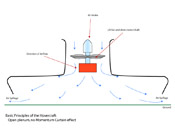
|
A basic hovercraft
This image shows a hovercraft model with an open plenum chamber filled with air by a lift fan. This design, although producing air for lift, also lets a lot of air escape around the edges due to the pressure difference between the underside of the craft, and the air surrounding it. |
In the 1930s the Soviets and Fins developed and tested ideas about Air Cushioned Vehicles on the sea, but sufficient funding was not granted to further the research.
Sir Christopher Cockerell (June 4, 1910 – June 1, 1999) [top]
The name of the famous British Inventor known worldwide as synonymous with the invention of the Hovercraft as we know it. Christopher Sydney Cockerell was born in Cambridge and studied engineering at Cambridge University. He conceived the hovercraft by discovering the Momentum Curtain theory (explained below) in 1953, demonstrating it in 1955 with a hair dryer and two coffee cans in an experiment famous in the hovercraft world (also explained below). He built a larger-scale demonstration of his concept and demonstrated it to as many parties as possible. Boating manufacturers claimed his invention to be an aeroplane, and nothing to do with them; Aeroplane companies claimed the opposite. Eventually a demonstration of the concept in front of officials of the British Government secured the invention's future, albeit through a period of its being sworn to secrecy.
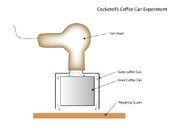
|
Coffee Cans
Cockerell's first experiment, derived from a hair dryer, a length of tubing, a pair of scales and two coffee tins. He measured the pressure generated from the hair dryer on its own compared to that generated by the coffee tins and found a nearly four-fold increase due to the momentum curtain! |
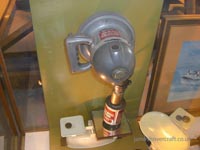 |
In 1959, funded and developed with the National Research and Development Corporation and built by Saunders Roe (Aviation) Ltd., Cockerell designed the first full-sized hovercraft, the SRN1 (Saunders Roe Nautical One). Following numerous on-land and on-sea trials on the Solent, the SRN1 made its historic cross-channel crossing between Calais (France) and Dover (England) on 25th July later that year. More about the SRN1 later in the tour.
Cockerell was knignted in 1969 for his services to engineering. [Wikipedia, 2008b; Hovercraft Museum, 2007]
The Momentum Curtain [top]
Cockerell's discovery of the Momentum Curtain revolutionised previous hovercraft and air-cushion theories. The air from the lift fan is not blown directly underneath the craft now, but instead is forced into a plenum chamber and directed as a jet around the edges of the craft, in an inwards direction. This creates a high velocity curtain of air, reducing the amount of escaping air and thus increasing the pressure of air trapped beneath the craft. The result is a greater hoverheight and more stability.
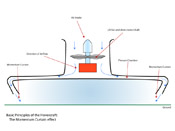
|
The Momentum Curtain
This image shows the theory in practise, as applied to the SRN1. Note the air directed under the craft in the form of jets, and imagine this as being applicable all the way around the craft as a wall of high pressure, high velocity air. It is the pressure underneath the craft, as well as a small amount of downward thrust generated by the air jets, which levitates the hovercraft. |
You may notice that unlike the original Victorian designs, there is no contact at all between the hull of the craft (now a hovercraft) and the surface of the water. This means that as well as contact friction being reduced to zero, the craft is capable of travelling over any surface be it water or land. It is therefore truly amphibious. The reason a hovercraft cannot fly high into the air is that it is lifted by the pressure of its lift air trapped between itself and the ground, and not the force of the thrust generated by the air moved by the lift fan itself. Therefore uneven terrain can cause air to escape, reducing the hoverheight or perhaps even grounding the craft. It is this reason which may irk the users of toy hovercraft, noticing they don't work well on carpets or grass!
Another advantage of having no contact between craft and medium is that it can traverse obstacles of height less than the hoverheight of the craft, such as waves, gulleys and rocks. The hoverheight here is determined as a function of the beam (width) of the craft, typically falling between 1/20th and 1/30th of this value. The SRN1, for example, had a hoverheight of 23cm.
Movement: Forward, backward and side-to-side [top]
It's all very well and good having a craft which can eliminate all friction between it and the land surface, but what good is this if it doesn't move! And, contrarily, how do you make a vehicle move if it is not in contact with the surface which it is required to move over? The answer is thrust, in the form of redirected air from the lift fan (such as in the first model of the SRN1), or from a seperate system of either thrust propellers or jet engines. Most craft now use propellers.
Propellers work by generating a lift force from their blades as they move through the air in a circle, much the same was as a swimmer kicks or pushes against the water as they swim. The action of the propeller moving against the air creates a force in line with Newton's 3rd Law, a.k.a., every action has an equal and opposite reaction. The air being pushed out of the way by the propeller exerts a force upon the propeller, in the opposite direction. This force is then carried through the propeller blade, through its centre spinner and into the craft's structure, propelling it forward. The pitch of the propeller blade, or its Angle of Attack, is the angle between the blade's cross-sectional longest axis (leading edge to trailing edge) and its direction of travel (parallel to the length of the blade). This pitch is responsible for the amount of force exerted by/on the air particles - the higher the pitch (to a limiting extent), the higher the force generated. Because force is proportional to acceleration, in Newton's 2nd Law (Force = mass x acceleration), the higher the pitch angle, the more the craft can accelerate or go faster.
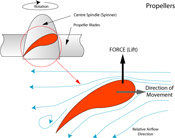
|
Propellers
Propellers are used on hovercraft and aeroplanes and any other use where direct contact with the ground to provide a force for movement is not possible. |
Now we have thrust, and therefore movement, we need steering to complete the process. Steering can be achieved in three ways on a hovercraft. By means of rudders behind the propeller or at the back of the craft, by means of moving the propellers themselves to change the direction of the thrust generated, or by means of moveable air ducts such as the bow thrusters on the AP1-88 (later in the tour).
Rudders act much like the steerable wheels on a car. The direction in which a rudder points affects the direction the craft goes, by deflecting the air hitting it in the opposite direction. Rudders normally have about 30 - 45° maximum range of movement either side of their normal direction (aligned with the craft's forward direction). They are usually located directly behind the propellers of a craft (such as in Tiger 12 and AP1-88) or at the rear of the craft, like in the SRN4 or later version of the VA-3.
Rotating the propellers can be a useful form of steering also, most popularly as utilized on the SRN4 hovercraft. This craft had four propellers mounted on swivelling pylons, each capable of moving 30° either side of their normal heading. The swivelling pylons meant that the craft could turn or even counteract drift caused by a crosswind. Directional control was provided by the direction of the thrust emitted by the propellers.
Bow thrusters are used along with rudders on the AP1-88. These use air bled from the lift system to push the craft in any direction. On this craft the bow thrusters can swivel up to 180° from their normal direction, allowing fine-tuned steering and even reverse thrust.
The Skirt [top]
Back to that ol' topic of obstacle clearance. The SRN1 hovercraft proved a great proof-of-concept model as it crossed the English Channel. However, to be of any practical use it had to be able to cope with more than a few small waves. To really take off, hovercraft would have to prove to be versatile and robust in all manners of weather or terrain conditions. It was thus required to find a way to increase the hoverheight significantly. Cecil Latimer-Needham was the engineer to do just that. He proposed a flexible skirt of rubber to be placed around the vents of the plenum chamber, trapping the air inside it as it inflated. This partly replaced the need for the momentum curtain, instead generating a second curtain at its base by means of inward-pointing flexible extensions known as fingers.
With the skirt, the hoverheight was increased more than tenfold, and obstacle clearance also greatly improved. Upon striking an obstacle or traversing uneven land or choppy seas, the skirt could give, or change shape, whilst still containing the air cushion within it, allowing the craft to continue a friction-free voyage over whatever it was moving across.
The skirt and its uses are detailed more clearly in the next few sections, including the SRN4 Feature Tour, and the SRN1 tour later.
This completes the Concept and Theory section of the tour, hopefully you'll now have an idea of why hovercraft were needed, how they fulfilled this niche and a few of their control mechanisms. The next few sections will cover these points in even more detail.






